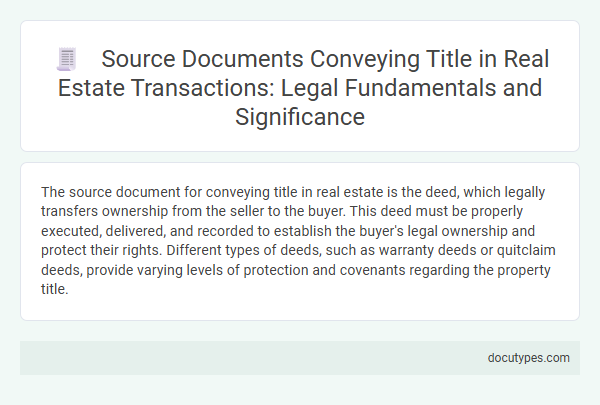The source document for conveying title in real estate is the deed, which legally transfers ownership from the seller to the buyer. This deed must be properly executed, delivered, and recorded to establish the buyer's legal ownership and protect their rights. Different types of deeds, such as warranty deeds or quitclaim deeds, provide varying levels of protection and covenants regarding the property title.
Introduction to Source Documents in Real Estate Transactions
| Introduction to Source Documents in Real Estate Transactions | |
|---|---|
| Definition of Source Document | Original legal documents that establish or transfer ownership rights in real estate. |
| Main Source Document for Conveying Title | The deed is the primary legal instrument used to transfer title from one party to another in real estate transactions. |
| Types of Deeds | Common types include warranty deeds, quitclaim deeds, and grant deeds, each offering different levels of protection for the buyer. |
| Role of the Deed | Serves as formal evidence of the transfer of ownership rights and must be properly executed, delivered, and recorded according to jurisdictional laws. |
| Importance of Recording | Recording the deed in public records protects your ownership rights and provides notice to third parties about the property title change. |
| Additional Source Documents | Other supporting documents like title abstracts, title insurance policies, and purchase agreements play important roles in verifying and safeguarding title. |
Legal Definition of Conveyance and Title Transfer
The source document for conveying title in real estate is the deed, a legal instrument that transfers ownership from one party to another. Conveyance legally establishes Your rights by documenting the transfer of title, ensuring the new owner's claim is recognized.
- Legal Definition of Conveyance - Conveyance is the act of transferring property ownership from the current owner to the buyer through a formal legal document.
- Title Transfer Mechanism - The deed serves as the primary source document that legally evidences the transfer of real estate title.
- Importance of the Deed - Recording the deed with the appropriate governmental entity provides public notice and secures Your ownership rights against future claims.
Primary Types of Source Documents Conveying Title
The source document for conveying title in real estate is a legal instrument that officially transfers ownership from the seller to the buyer. These documents serve as proof of title and establish the buyer's legal rights to the property.
Primary types of source documents include deeds, such as warranty deeds, quitclaim deeds, and grant deeds. Each deed type conveys title with varying levels of guarantees regarding the property's ownership history and liens.
Deeds: Forms and Legal Requirements
The primary source document for conveying title in real estate is the deed. Deeds serve as the legal instrument that transfers ownership from the grantor to the grantee.
Different forms of deeds exist, including warranty deeds, quitclaim deeds, and special purpose deeds, each with specific legal requirements and implications. A valid deed must be in writing, contain a clear description of the property, identify the parties involved, and be properly signed and notarized. Your careful review of the deed ensures clear and marketable title during real estate transactions.
The Role of Title Certificates in Property Ownership
What is the source document for conveying title in real estate?
The source document for transferring property ownership is the deed, a legal instrument that officially records the conveyance of title from seller to buyer. Title certificates play a crucial role by verifying the ownership status and confirming that the title is free of liens or encumbrances.
Registration and Recording: Establishing Legal Priority
The source document for conveying title in real estate is typically the deed, which serves as the official record transferring ownership from the grantor to the grantee. This legal instrument must be properly executed and delivered to ensure a valid transfer of title.
Registration and recording of the deed play a crucial role in establishing legal priority and protecting ownership rights against third parties. Recording the deed in the appropriate government office provides public notice, effectively securing the grantee's interest and preventing future disputes over title.
Significance of Accurate Documentation in Title Conveyance
The source document for conveying title in real estate is typically the deed, a legal instrument that transfers ownership from the seller to the buyer. Accurate documentation in title conveyance is crucial to protect property rights and prevent future disputes.
- Deed as Primary Document - The deed serves as the official record establishing legal ownership of the property.
- Prevents Ownership Disputes - Precise and clear documentation minimizes risks of conflicting claims and litigation.
- Ensures Marketability - A properly executed deed guarantees the property can be sold or leveraged effectively in the future.
Your attention to detail in securing correct documents ensures a seamless real estate transaction and protects your ownership rights.
Risks of Defective or Fraudulent Source Documents
The source document for conveying title in real estate is typically the deed, which legally transfers ownership from the seller to the buyer. Risks of defective or fraudulent source documents include invalid transfer of title, undisclosed liens, or title disputes that may arise after the transaction. These risks can lead to costly legal battles, loss of property rights, and financial damages for purchasers and lenders involved.
Legal Remedies for Issues in Title Documents
The source document for conveying title in real estate is the deed, which legally transfers ownership from the seller to the buyer. Legal remedies for issues in title documents include quiet title actions, title insurance claims, and corrective deeds to resolve defects or disputes. You should seek professional legal advice promptly if discrepancies arise to protect your ownership rights effectively.
What Is the Source Document for Conveying Title in Real Estate? Infographic

